MARIANI’S
Virtual Gourmet
October
25, 2020
NEWSLETTER
ARCHIVE
.jpg)
❖❖❖
IN THIS ISSUE
A GREAT CITY IS MADE
TO STROLL FOREVER
By John Mariani
NEW YORK CORNER
LOVE AND PIZZA
CHAPTER THIRTY-ONE
By John Mariani
NOTES FROM THE WINE CELLAR
THE SPARKLING WINES OF TRENTINO
By John Mariani
❖❖❖
A GREAT CITY IS ONE WHERE
YOU CAN STROLL FOREVER
By John Mariani
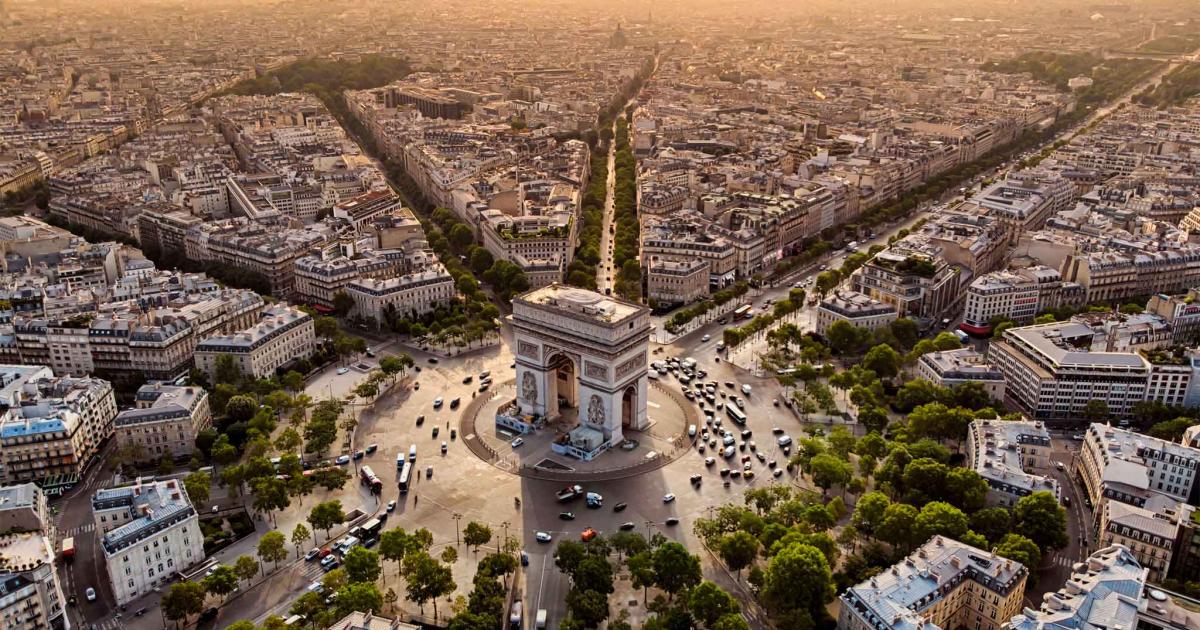
As
people discover the renewed joys of taking a
long walk during this pandemic crisis, I doubt
there is anyone who is not daydreaming about
places they have been or may now never get to. I
have been watching some of the travel shows on
TV with a different cast of mind, including one
of those old MGM “Traveltalks” shorts from the
1930s hosted by the “Voice of the Globe,” James
A. Fitzpatrick, who always ended his ten-minute
travelogues saying of every destination, “And so
we reluctantly say goodbye to . . . .”
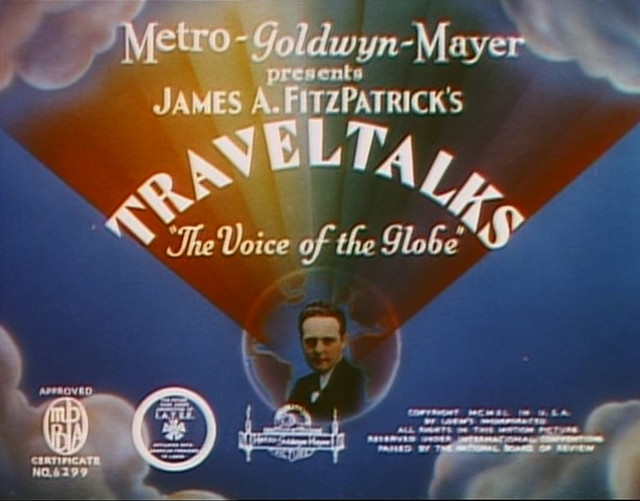 The
cinematography, though in Technicolor, was not of
the highest quality, and no topic was dwelt on for
more than a few seconds, but the series presented
the charms of places most Americans would never
have otherwise had a glimpse of, much less travel
to. World War II put a big crimp in Fitzpatrick’s
foreign travel, but he thereupon exuded as much
enthusiasm over “Old New Orleans” and “Mighty
Niagara” as he had over “Picturesque Udaipur” and
“Serene Siam.”
The
cinematography, though in Technicolor, was not of
the highest quality, and no topic was dwelt on for
more than a few seconds, but the series presented
the charms of places most Americans would never
have otherwise had a glimpse of, much less travel
to. World War II put a big crimp in Fitzpatrick’s
foreign travel, but he thereupon exuded as much
enthusiasm over “Old New Orleans” and “Mighty
Niagara” as he had over “Picturesque Udaipur” and
“Serene Siam.”
As I watched “Beautiful Budapest” (below)
a city I adore for its beauty, its museums, 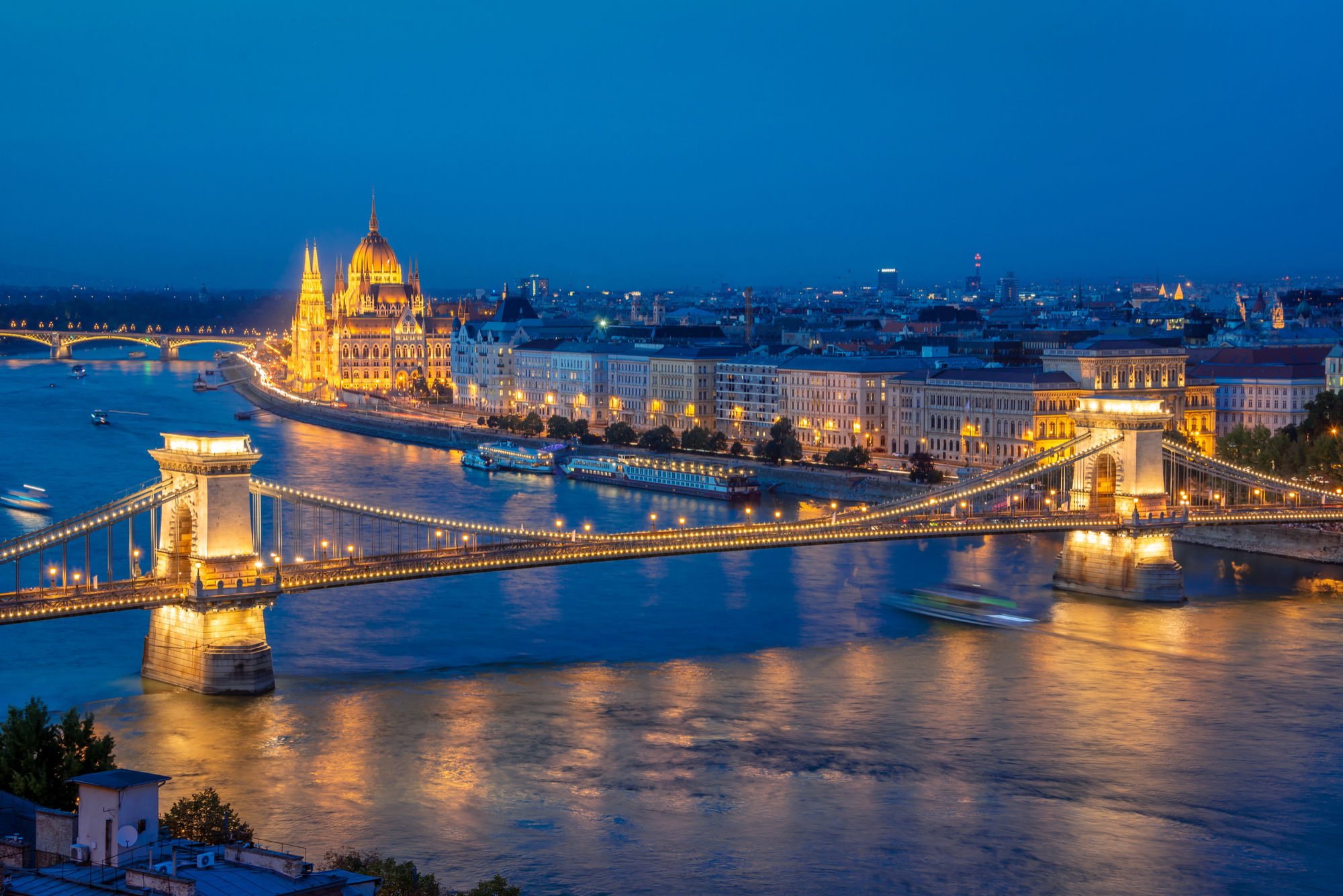 its
food and its lay-out on both sides of the Danube
River, I realized that all great cities, and many
smaller ones, are those where strolling for hours
down grand boulevards like the Champs Élysées or
the National Mall in Washington is key to finding
what makes them endlessly fascinating, again and
again, so that we always want to return to retrace
our old steps and set out on new ones.
its
food and its lay-out on both sides of the Danube
River, I realized that all great cities, and many
smaller ones, are those where strolling for hours
down grand boulevards like the Champs Élysées or
the National Mall in Washington is key to finding
what makes them endlessly fascinating, again and
again, so that we always want to return to retrace
our old steps and set out on new ones.
The narrow streets of Florence will
suddenly open onto a vast piazza like San Lorenzo,
Signoria, Strozzi, del Duomo; a stroll along New
York’s Museum Mile brings you past Central Park
and its Children’s Zoo, flanked by the
Metropolitan Museum of Art, the Guggenheim, the
Frick Collection, the Africa Center, El Museo del
Barrio, Museum of the City of New York, the Jewish
Museum, the Cooper Hewitt, the Neue Gallerie and
the National Academy Museum. A stroll along the
Chicago River (below) will be an instant
education in American architecture, from the
Tribune Tower and Merchandise Mart to the Harry
Weese  River Cottages
and Erie Park. Boston’s two-and-a-half-mile
Freedom Trail winds through the city showing the
most important locations of the burgeoning
Republic, from King’s Chapel and Park Street
Church to the Boston Massacre Site and the Old
North Church, where the lamps were lighted to send
Paul Revere on his famous ride.
River Cottages
and Erie Park. Boston’s two-and-a-half-mile
Freedom Trail winds through the city showing the
most important locations of the burgeoning
Republic, from King’s Chapel and Park Street
Church to the Boston Massacre Site and the Old
North Church, where the lamps were lighted to send
Paul Revere on his famous ride.
Easily as wonderful and diverse are
neighborhoods like Trastevere in Rome, Montmartre
in Paris, Soho in London, Buenos Aires’s Italian
section called La Boca and the sprawling night
markets of Taipei. You can follow Leopold Bloom’s
footsteps from James Joyce’s Ulysses
in Dublin, Hemingway’s haunts on Montparnasse,
even film locations in New York from the movie Goodfellas.
There are always streets lined with
boutiques, food shops, cafés, artisan shops, bars
and nightclubs. In Toledo (below) you can
stand across from the landscape El Greco so
famously painted of the Spanish city, in Berlin
walk along the remains of the graffiti-painted
Wall and in Quebec City stand on the Plains of
Abraham, where the British took the city from the
French..jpg)
Walking up impossibly steep streets in San
Francisco, finding Juliet’s balcony in a cul de
sac in Verona and stopping for coffee and
schnitzel on Vienna’s Ringstrasse make for
indelible memories. And you realize after
returning home that you’ve only scratched the
surface of a city. In each, everyone visits the
top sights—the Eiffel Tower, the Statue of
Liberty, Trafalgar Square and so on—but few get to
the lesser known attractions that a great city
offers in dizzying array, like Paris’s flea
markets called Les Puces, the quarter around the
Istanbul Bazaar and Milan’s bustling Navigli
neighborhood along the river.
 Such a bounty of cultural
riches, reached largely on foot, day after day,
hour after hour, is what makes a city great, while
other cities, however large, work against the idea
of extensive, slow walking. Every city has its
street-side attractions—the bizarre extravagance
of Las Vegas’s Strip, the Indian Market of Santa
Fe, the waterfront of San Juan and painted
boulevard of Copacabana in Rio (left). But
once walked through, there are only a very limited
number of streets or neighborhoods in those cities
one can traverse on foot. Cities like Atlanta, Los
Angeles, Denver, Houston and Phoenix (all with
first-rate, if few, museums) are so spread out by
design that there is nowhere to go beyond the
downtown center, which in many of those cities are
the dreariest part.
Such a bounty of cultural
riches, reached largely on foot, day after day,
hour after hour, is what makes a city great, while
other cities, however large, work against the idea
of extensive, slow walking. Every city has its
street-side attractions—the bizarre extravagance
of Las Vegas’s Strip, the Indian Market of Santa
Fe, the waterfront of San Juan and painted
boulevard of Copacabana in Rio (left). But
once walked through, there are only a very limited
number of streets or neighborhoods in those cities
one can traverse on foot. Cities like Atlanta, Los
Angeles, Denver, Houston and Phoenix (all with
first-rate, if few, museums) are so spread out by
design that there is nowhere to go beyond the
downtown center, which in many of those cities are
the dreariest part.
Not
only because of the heat but because of the
sterility of the massive high-rises that line the
broad avenues of Dubai (below) and Abu
Dhabi does a ten-minute walk seem more than enough
before heading for the air-conditioned indoor
shopping malls. Brazil’s capital, Brasilia, has
its Monumental  Axis park, but
little else to make you want to walk around the
city. And most of the old neighborhoods have been
razed in Chinese cities dating back millennia.
Axis park, but
little else to make you want to walk around the
city. And most of the old neighborhoods have been
razed in Chinese cities dating back millennia.
Most of these cities have been planned
according to modern ideas of architecture and
civic hubris by which size and scope blots out
history and charm. In New York, narrow set-backs
have meant less and less light enters into midtown
Manhattan any more. Los Angeles was built around a
mouse maze of a Freeway system rather than to
benefit neighborhoods, so that it is still
maddening to traverse Malibu to downtown L.A. west
to east, because the roads were not built to do
so. Even Paris has ringed its historic core with
buildings that are not only cookie-cutter ugly but
bear no relation to traditional Parisian culture
and offer no reason to walk through them unless
one works there. And London’s new business center,  Canary
Wharf (below), might as well be located in
Dallas. It
should be noted that the Paris we know today was
the result of razing vast swathes of old Gothic
neighborhoods by Baron Haussmann, and there is
almost nothing left of pre-19th century New York
downtown.
Canary
Wharf (below), might as well be located in
Dallas. It
should be noted that the Paris we know today was
the result of razing vast swathes of old Gothic
neighborhoods by Baron Haussmann, and there is
almost nothing left of pre-19th century New York
downtown.
Some years ago, I exited what
was then called the Beverly Wilshire Hotel, and,
having exhausted all the commercial attractions of
downtown Beverly Hills, I strolled up into the
residential section of the city, whose eerie quiet
was broken only by the sounds of sprinklers
whooshing back and forth across perfectly groomed
lawns. I was dressed in shorts and a tennis shirt,
when suddenly I heard the whoop! whoop!
of a police car. It stopped next to me, its lights
still flashing, and two Beverly Hills cops
(neither of whom looked like Eddie Murphy in the
movie) got out and asked me for identification. I
said I wasn’t carrying any because I was just taking a
walk! Had I been an African-American I’m
sure the cops would have pushed me up against
their car and frisked me. They did not—not much
space to hide a gun in my outfit—but they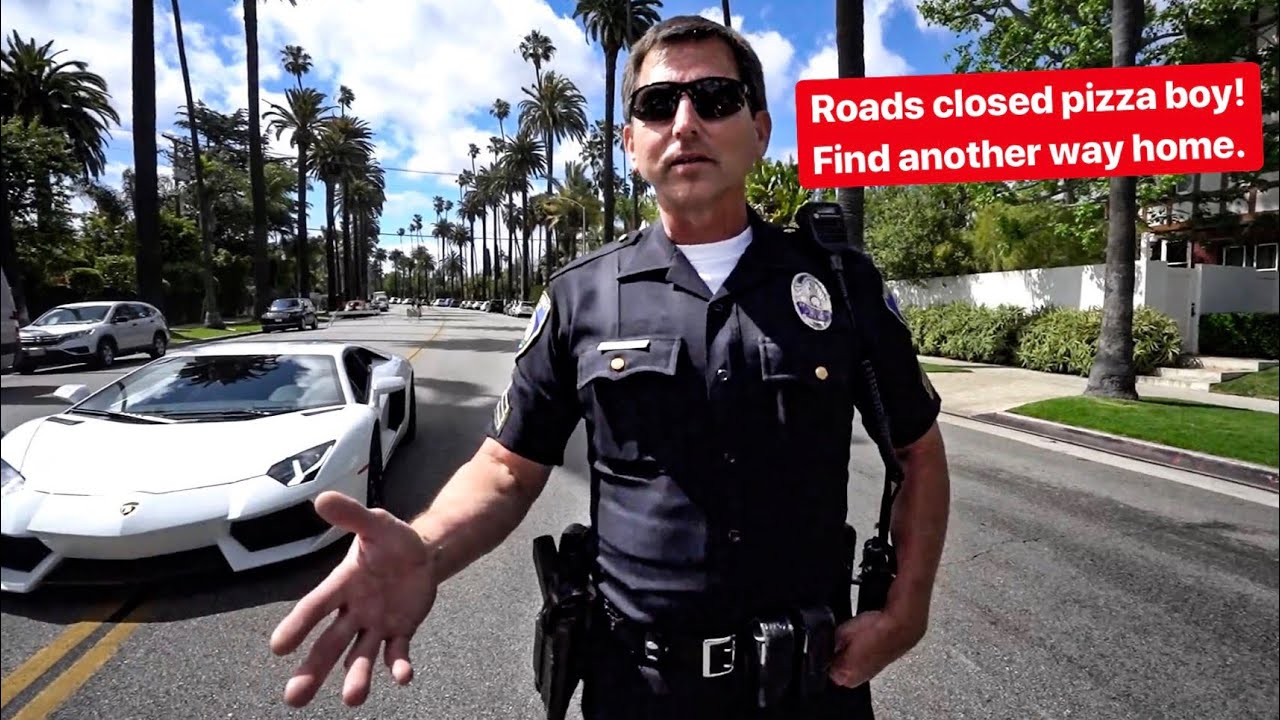 were very suspicious of anyone who would take a walk
through Beverly Hills, as if the people who lived
there no longer had use of their lower limbs and
were all lifted into limos to go anywhere. Perhaps
they assumed I was casing the mansions with an eye
to breaking into them at eleven in the morning.
They let me go with a suggestion I don’t try taking a walk
through the neighborhood ever again.
were very suspicious of anyone who would take a walk
through Beverly Hills, as if the people who lived
there no longer had use of their lower limbs and
were all lifted into limos to go anywhere. Perhaps
they assumed I was casing the mansions with an eye
to breaking into them at eleven in the morning.
They let me go with a suggestion I don’t try taking a walk
through the neighborhood ever again.
The incident made me realize what a
soul-less city it was, a place where nobody walks
anywhere, a city where going to a supermarket or
dry cleaners three blocks away is reason to get in
a car and drive there and where anyone walking
through the neighborhood should be eyed with
suspicion with 911 on speed dial.
That’s not the way it is in a city where
everyone walks or bicycles everywhere
to buy a loaf of bread, meet a friend for lunch or
pick up one’s children from school. That’s not the
way it is when people lean out their windows
throughout the day and evening to chat with
friends across the way, keep an eye on things and
watch the passing parade.
I miss
all this very much during this damnable pandemic,
and I’m very glad I live in a neighborhood (albeit
in the ‘burbs) where I can walk to everything,
wave to people I know and don’t know, and feel
that no cop’s car will be bearing down in me.
❖❖❖
By John Mariani
LOVE AND PIZZA
Since, for the time being, I am unable to write about or review New York City restaurants, I have decided instead to print a serialized version of my (unpublished) novel Love and Pizza, which takes place in New York and Italy and involves a young, beautiful Bronx woman named Nicola Santini from an Italian family impassioned about food. As the story goes on, Nicola, who is a student at Columbia University, struggles to maintain her roots while seeing a future that could lead her far from them—a future that involves a career and a love affair that would change her life forever. So, while New York’s restaurants remain closed, I will run a chapter of the Love and Pizza each week until the crisis is over. Afterwards I shall be offering the entire book digitally. I hope you like the idea and even more that you will love Nicola, her family and her friends. I’d love to know what you think. Contact me at loveandpizza123@gmail.com
—John Mariani
To read previous chapters go to archive (beginning with March 29, 2020, issue.
LOVE AND PIZZA
Cover Art By Galina Dargery
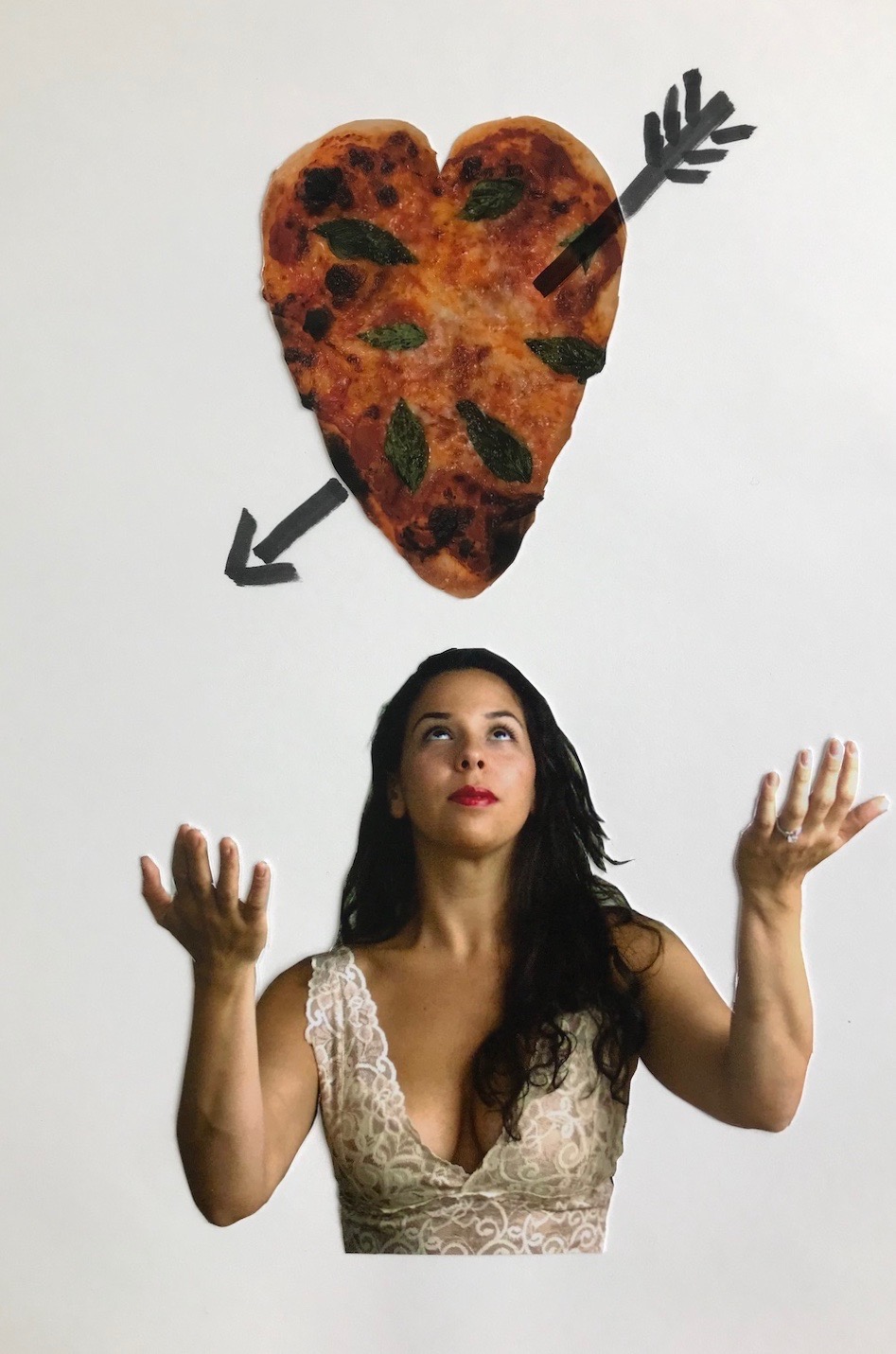
CHAPTER THIRTY-ONE
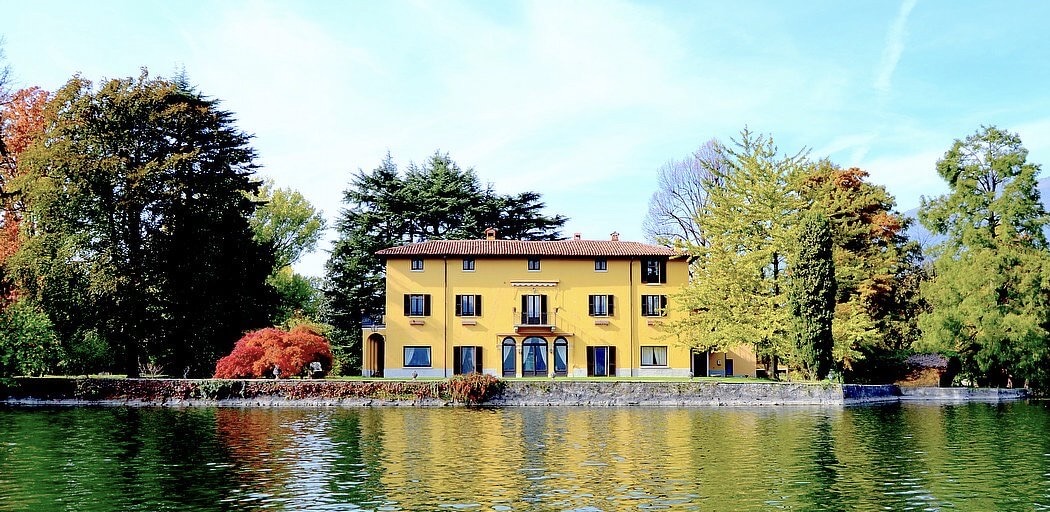
Giancarlo’s
driver
arrived promptly at two o’clock and they were
outside the city on the A4 before the rush
hour hit. Less than two hours later the car
turned onto the A21 towards Alba, skirted the
town and headed into the foothills that give
Piemonte its name.
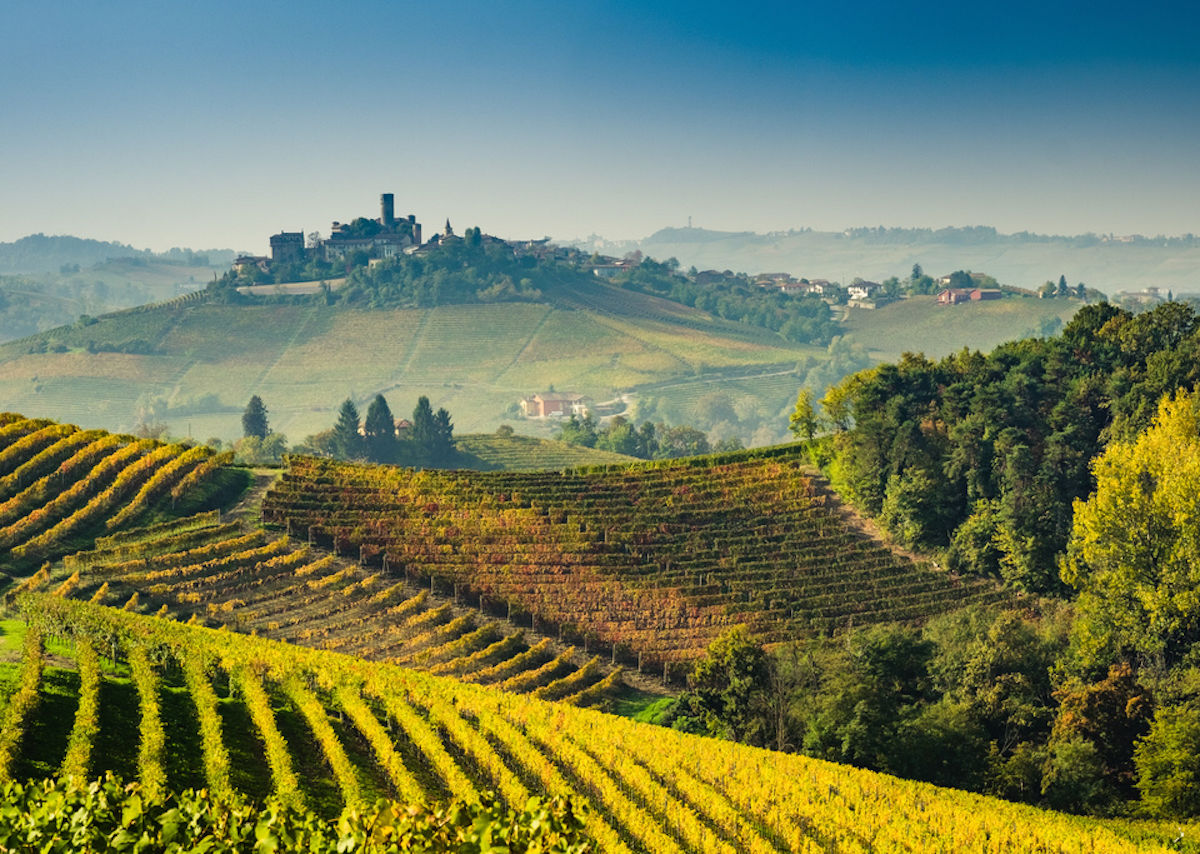 They
passed dozens of vineyards with names vaguely
familiar to Nicola—she’d been trying to learn
more about the wines of the region—then drove
down a long country road lined with cypress
trees and vineyards, finally coming into view of
the Cavallacci villa on a rise.
They
passed dozens of vineyards with names vaguely
familiar to Nicola—she’d been trying to learn
more about the wines of the region—then drove
down a long country road lined with cypress
trees and vineyards, finally coming into view of
the Cavallacci villa on a rise.
Nicola did a little research on the
property and found that its original structure
dated back at least three centuries before the
Cavallaccis obtained the villa in the 19th
century. The structure looked to be in splendid
shape, the grounds well landscaped but without
the kind of geometric layout found in larger
villas like Rome’s Tivoli. Nor was it one of the
sober-looking neo-classical 16th century villas
built by Andrea Palladio in Veneto.
Villa Cavallacci was more rustic, though
highly refined, more an extravagant, three-story
farmhouse set on a lake than a pillared
residence with lavish landscaping. Given
the Cavallaccis’ holdings in stone and marble,
the surfaces of the villa were of superb quality
and kept in pristine condition—certainly a fine
advertisement for the company to anyone
visiting.
The driver pulled up to the front of the
villa, where Nicola was received by a man and
woman of the staff, welcoming her and taking her
bag, then showing her to her room, which was
about four times the size of her dorm room and
decorated in a restrained décor of ceiling
beams, painted tile floors, a sofa, antique
writing desk and a bed covered with very fine
linens and a satin cover. The bathroom was not
huge but very well appointed in marble. There
were two paintings on the wall, both from the
late Middle Ages, their backgrounds in gold
leaf.
There was a knock on the open door and
the woman who’d received Nicola entered,
carrying a bowl of fruit and fresh roses. She
asked if Nicola wanted the windows opened,
Nicola nodded, and soon the smell of vineyard
land blew through the room to mingle with the
perfume of the roses.
Nicola was puzzled as to why she had not
yet met any members of the Cavallacci family,
so, in Italian, she asked the maid, “Is the
Cavallacci family here yet?”
The woman said that only the marchese and
his wife were on the premises at the moment but
that the others would be arriving later or the
next day for the party. This report caused
Nicola further puzzlement as to why the
Cavallaccis had not welcomed her in person. Then
she thought that perhaps the old marchese was
not well that day and that his wife was tending
to him in another part of the villa.
So, she decided, there was
nothing more to do than to tour the property
until she was introduced to the family. As she
left the front door and began walking towards
the vineyards, she heard the double honk of a
car horn. A
low-slung red Alfa Romeo pulled up and Giancarlo
bounded out of it, running to Nicola, taking her
in his arms and saying how thrilled he was to
have her at his family home.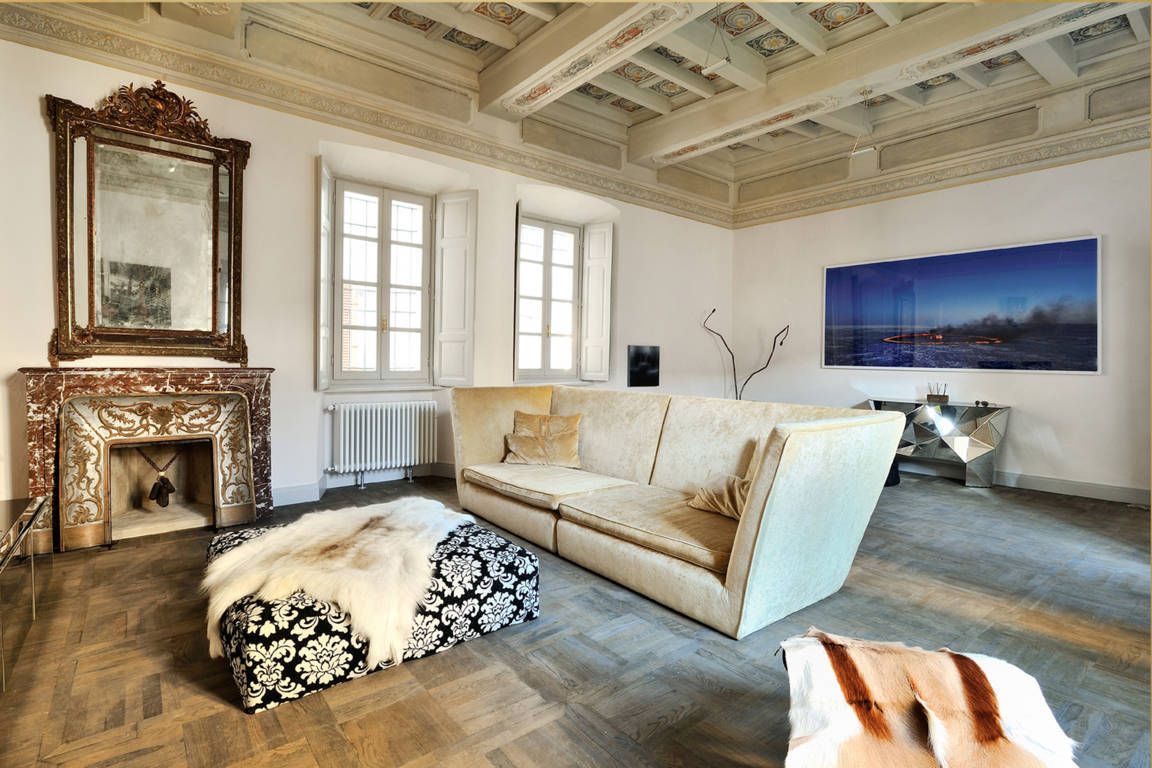
After a few more words of welcome, he
asked, “Have you met my mother and father yet?”
Nicola shook her head and said, “No, but
I was told they’re here.”
This surprised Giancarlo, who grimaced
slightly and said, “Well, perhaps my father is
not feeling well today. I’m
sure they will be out to meet you soon.”
At that, the couple heard a woman at the
front door cry, “Giancarlo! Caro!
Bentornato!”
It was the marchesa, whose Austrian blood
showed clearly in both her height and coloring,
her silver-white hair pulled back in a ponytail. She
was dressed casually but with definite care—a
butter yellow blouse, tailored pleated tan
slacks and soft brown loafers.
Giancarlo brought Nicola over to his
mother, whom he kissed on both cheeks then said,
“Mamma,
permettetemi di introdurre mia amica Nicola
Santini.”
Nicola put out her hand, which was taken
by the marchesa, who spoke Italian with just the
slightest German accent.
“I understand you speak Italian, Signorina?”
“Yes,” said Nicola, “My father’s people
were from the Abruzzi and my mother’s from
Campania.”
All the marchesa responded was, “Ah,”
then began speaking with Giancarlo, telling him
his father was not too well that day, resting up
for his birthday party tomorrow. “I
don’t think he will be at dinner tonight, but
he’s basically all right. Will you two be
joining us for dinner?”
“Ah, I would love to, Mamma,” said
Giancarlo, sounding like a little boy, “but I
promised Nicola I would take her to dinner in
Torino—she’s never been there. I hope you don't
mind.”
The marchesa gave a little shrug and
said, “Well, if you promised to take la
signorina to Torino, I suppose there’s
nothing I can do.”
Nicola ascribed the marchesa’s coolness
both to her Austrian bloodlines and to her
taking offense that her darling son would not
stay for dinner.
It occurred to Nicola that perhaps the
marchesa had not seen her son for a while.
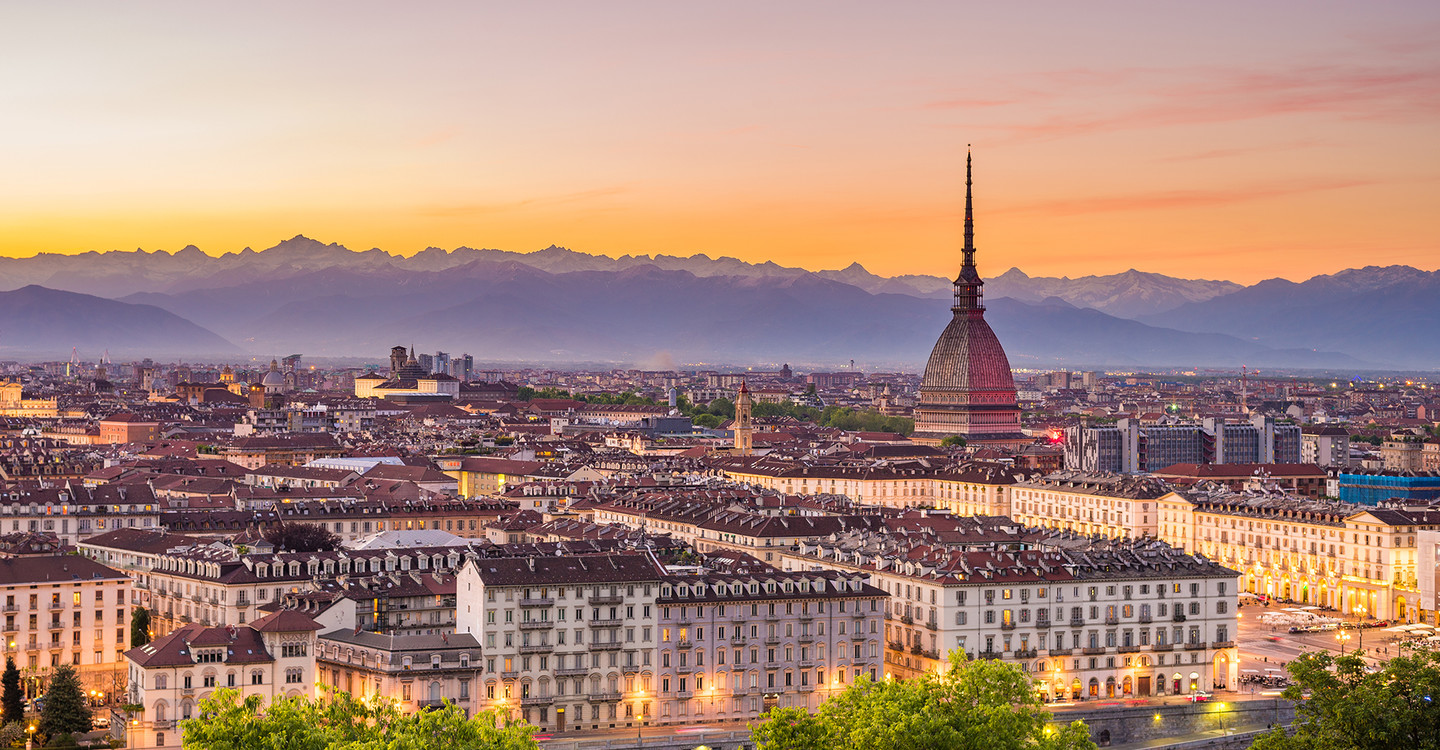 The
marchesa smiled at Nicola and said, now speaking
English, “Well, then, I will see you tomorrow
for the party. Buona sera.”
The
marchesa smiled at Nicola and said, now speaking
English, “Well, then, I will see you tomorrow
for the party. Buona sera.”
Nicola looked at Giancarlo with concern. He
took her by the arm and said, “Don’t
worry. She’s
disappointed we won’t dine with her, but she’ll
be very busy with preparing for tomorrow and
will forget all about us.” Then
Nicola remembered what Catherine had said about
impressing the family and didn’t think things
were off to a good start.
During the hour’s drive to Turin, Nicola
showed sincere interest in the villa’s history,
and Giancarlo knew a great deal about it, having
been educated and appointed to carry on the
family name and its holdings. Again he told
Nicola that his interests did not lie in
becoming the industrial titan his father saw him
as but that his fealty to his family ran very
deep.
Giancarlo then provided a few insights
into the city of Turin, saying, “Not
even the Italians know Turin. They only know
FIAT! FIAT! FIAT!
This is not necessarily a bad thing,
however, because not many tourists go there, so
the city is never noisy, never crowded. So, we
Torinesi have our restaurants and caffés all to
ourselves most of the time.”
He then noted that, despite the city’s
industrial image, director Michelangelo
Antonioni used Milan in La Notte,
Rome in L’Eclisse
and Ravenna in Il Deserto
Rosso—not Turin—to depict the deadening
effect of industrialization on the soul of
modern Italy.
As they drove into the center of the
city, Nicola marveled at the long, graceful,
justly famous series of arcades, the grandeur of
its vast piazzas, and its stately and highly
efficient grid pattern. Giancarlo took her
for a brief tour, past Victor Emmanuel II’s high
baroque Royal 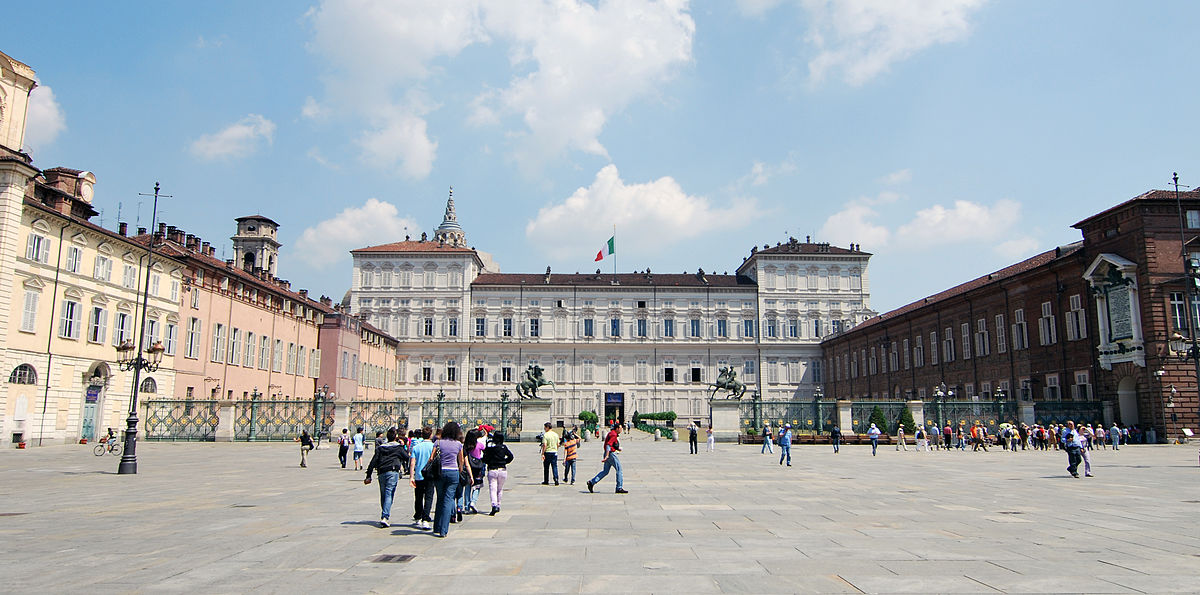 Palace
and the splendid Duomo of St. John the Baptist.
Palace
and the splendid Duomo of St. John the Baptist.
Giancarlo turned
into the beautiful Piazza Carmignano and parked
the Alfa. Dinner that evening was at Ristorante
Del Cambio, a grand dining salon in the league
of Savini in Milan, and was obviously chosen
because the Cavallacci family had been going
there for generations—perhaps since the
restaurant opened back in 1757. Since
then it had entertained Casanova,
Cavour, and Goldoni, and 19th century society
adopted it as requisite for a visit to Turin.
Yet by 1985 the restaurant had seen
better days, its kitchen had grown tired, the
dovetail coated wait staff geriatric and its
historic furnishings—Neoclassical wood paneling,
paintings on glass by Bonelli, and baroque
stuccos—looked worn and lacked the luster that
ever would have drawn someone like Nicola and
her friends.
The young couple was, of course, given
the Cavallacci’s usual table, although the place
had so few guests that night—none of them under
fifty—they might have sat anywhere they pleased. Nicola
opened the menu, which was a balance of
continental and Piemontese cuisines, but she
left the choice to Giancarlo, who had his
favorite dishes, which included Del Cambio’s
signature risotto
alla Cavour, 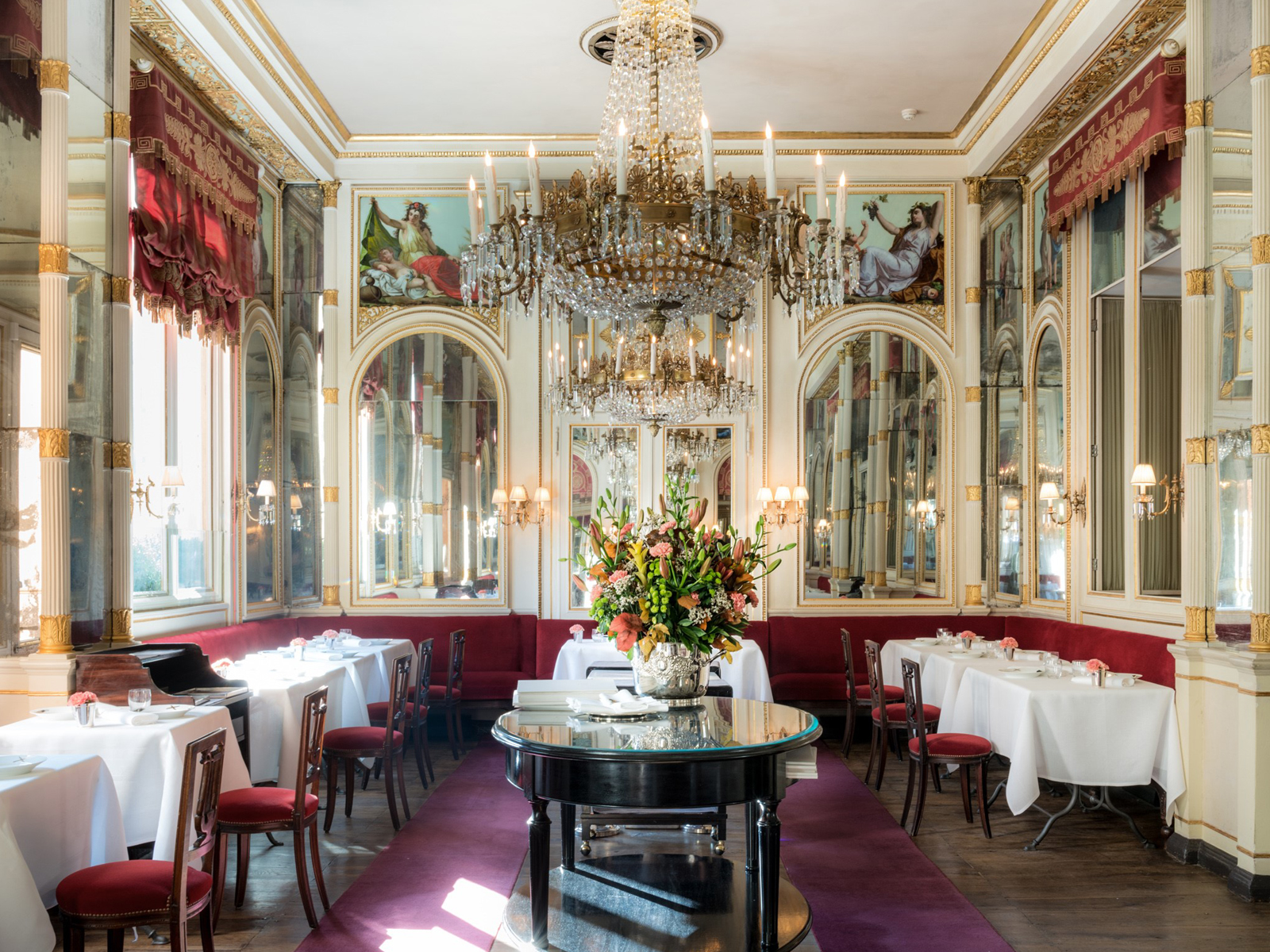 cooked in
white wine, with a poached egg and Parmigiano to
enrich it. They also enjoyed delicately flavored
cannelloni
stuffed with cauliflower, and stinco di
vitello, a succulent and tender shank of
veal braised in vegetables and wine. With their
meal Giancarlo had chosen a fine Piedmont Barolo
from an old producer named Pio Cesare.
cooked in
white wine, with a poached egg and Parmigiano to
enrich it. They also enjoyed delicately flavored
cannelloni
stuffed with cauliflower, and stinco di
vitello, a succulent and tender shank of
veal braised in vegetables and wine. With their
meal Giancarlo had chosen a fine Piedmont Barolo
from an old producer named Pio Cesare.
Oddly, the conversation at the table
seemed a bit staid to Nicola, which she
attributed to the hushed ambiance of a room
three-quarters empty. Giancarlo
didn't need to ask for the bill, of course, so
after finishing their wine he said, “We’re not
going to have dessert here. I want to take you
to Torino’s most beautiful caffé, Baratti e
Milano" (below).
The
couple left arm in arm under a three-quarter
moon, walking easily to Piazza Castello (above)
under the caress of the city’s archways. When
they got within ten yards of the caffé, they
could already smell the aroma of coffee and
chocolate.
When they entered they found just about
every table occupied, but Giancarlo said he
preferred to stand at the bar and have his
coffee and dessert.
The room was tantalizing to Nicola,
everything Del Cambio was not. She listened to
the music of the Piemontese dialect being spoken
and watched the white-coated barristas
grind, pack, adjust, steam, 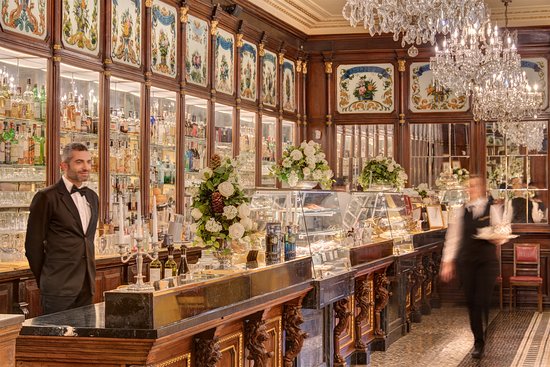 fizz, and
present their handiwork in a manifestation of
Turin’s deeply ingrained coffee culture, richer
than anywhere else in coffee-obsessed Italy. The
thunder of the shuddering coffee machine, the
clink of the cups and saucers hitting the
mahogany bar and the tinkle of the little spoons
in the saucer never let up. The barristas
poured a glass of Asti spumante for some, a
tipple of vermouth—a spirit invented in Turin—or
a dark, bittersweet amaro
digestiva for others. Giancarlo ordered a
slice of sugar-dusted cake covered with satiny
dark chocolate, with a filling of gianduja,
the chocolate-and-hazelnut cream that was also
created in Turin.
fizz, and
present their handiwork in a manifestation of
Turin’s deeply ingrained coffee culture, richer
than anywhere else in coffee-obsessed Italy. The
thunder of the shuddering coffee machine, the
clink of the cups and saucers hitting the
mahogany bar and the tinkle of the little spoons
in the saucer never let up. The barristas
poured a glass of Asti spumante for some, a
tipple of vermouth—a spirit invented in Turin—or
a dark, bittersweet amaro
digestiva for others. Giancarlo ordered a
slice of sugar-dusted cake covered with satiny
dark chocolate, with a filling of gianduja,
the chocolate-and-hazelnut cream that was also
created in Turin.
The couple’s conversation had picked up,
they were laughing, and Nicola took pleasure in
wiping a smudge of gianduja from
Giancarlo’s lips.
During the drive home there was a quiet
both young people seemed to welcome. Nicola had
hoped they might stay over at the Cavallaccis’
house in Turin, but as Giancarlo drove out of
the city she seemed resigned to spending the
night in separate bedrooms back at the villa. So
that by midnight their night was ending.
Standing outside in the villa’s vineyards,
embracing and kissing in the moonlight, Nicola
asked when they would be truly together for an
entire night.
“It’s impossible while we are here with
my family,” said Giancarlo. “But soon, Nicolina.
I promise.”
Neither slept well that
night.
© John Mariani, 2020
An Interview with Casa Monfort's Winemaker
By John Mariani
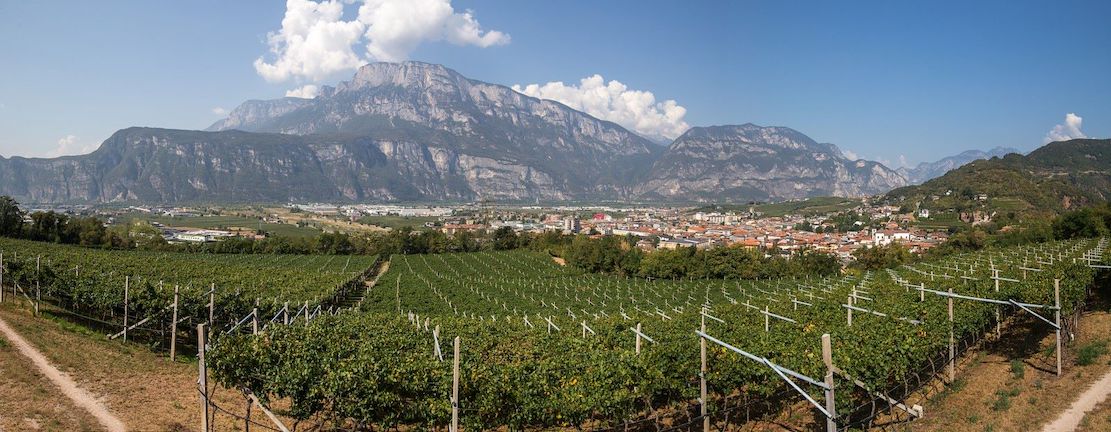
Italy’s
mountainous province of Trentino, usually
linked with Alto Adige, is in the extreme
northeast of the country, bordering Lombardy
and the Veneto as well as Austria, so it
shares in all those cultures’ history and
language. Indeed, many of the region’s
best-known dishes, like Spätzle, Graukäse
cheese, Speck bacon and Zelten Christmas cake
have German-Austrian names. So, too the
region’s wines overlap with the others’, with
Gewürztraminer, Sylaner and Riesling among the
varietals.
Trentino has its own
large DOC zone, but its wines have yet to
achieve the worldwide reputation of other
regions like Tuscany and Piedmont. Cantine
Monfort is one of the area’s
finest producers, with four generations of
family passion behind it. They are fine
examples of dedication to the particular
terroir. To find out more about their wines
and about Trentino’s reputation in the
modern market, I interviewed winemaker and
family scion Federico Simoni.
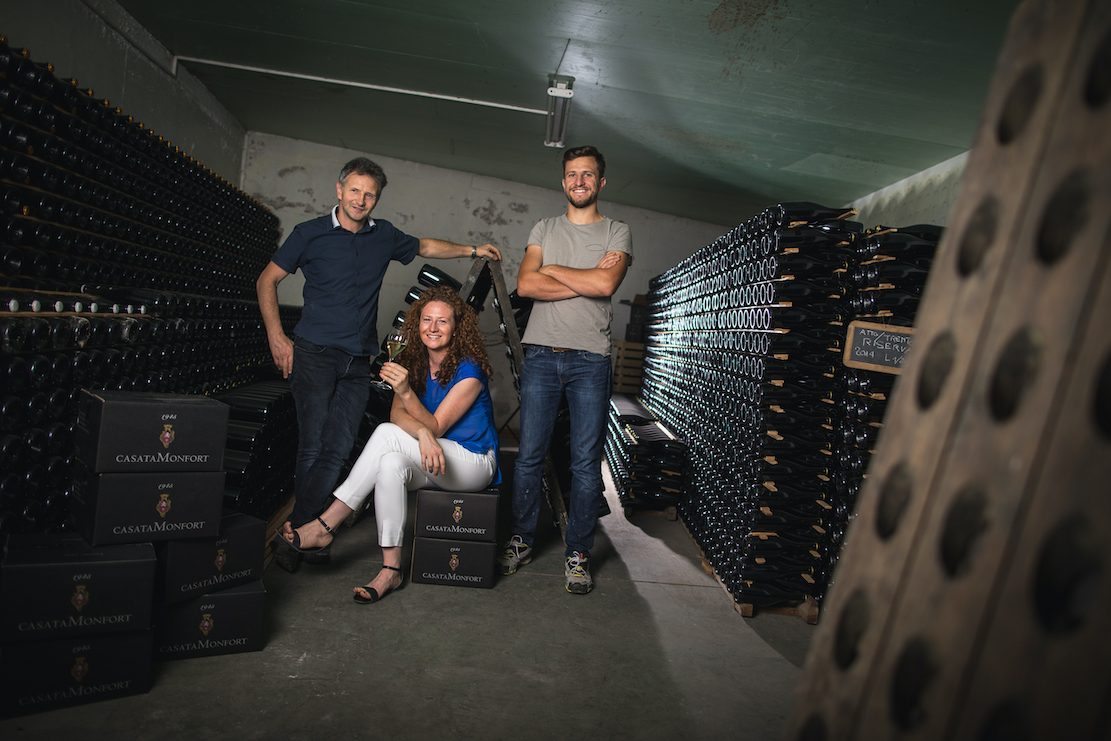
Lorenzo, Federico and Chiara Simoni
1. Can you tell me more about the particular terroir of Trentino?
Trentino is a small mountainous province located in Northern Italy (70% of the surface is above 1,000 meters of altitude!). Viticulture takes place in the valleys surrounded by the Dolomite mountains where the soil—a unique result of diverse geology, and Mediterranean and Alpine climate—strongly influences the grapes. In particular, our Trentodoc from Cantine Monfort is born in the vineyards located in Val dell'Adige, Val di Cembra and in Valsugana at an altitude between 200 and 900 meters above the sea level. Here you’ll find significant diurnal temperature variations, giving grapes aromatic complexity, elegance and freshness and with terroir that is rich in limestone with a high siliceous component.
2. Do the wines share anything in common with Austrian-German wines?
From a tasting point of view, the wines of Trentino represent a bridge between the Latin world and the world of Austria-Germany. We combine both the pleasantness and sweetness of the Mediterranean but also the verticality typical of Nordic wines. These are the wines that best represent Trentodoc. From a historical point of view, we have a long history and strong influence from the German wine culture and I think that the most important legacy for us oenologists from Trentino was the famous school of oenology, the now called Edmund Mach Foundation, founded by the Austro-Hungarian Empire in 1874.
3. Can you tell the similarities of your sparkling wines with Champagne, Piemonte sparkling wines and Prosecco?
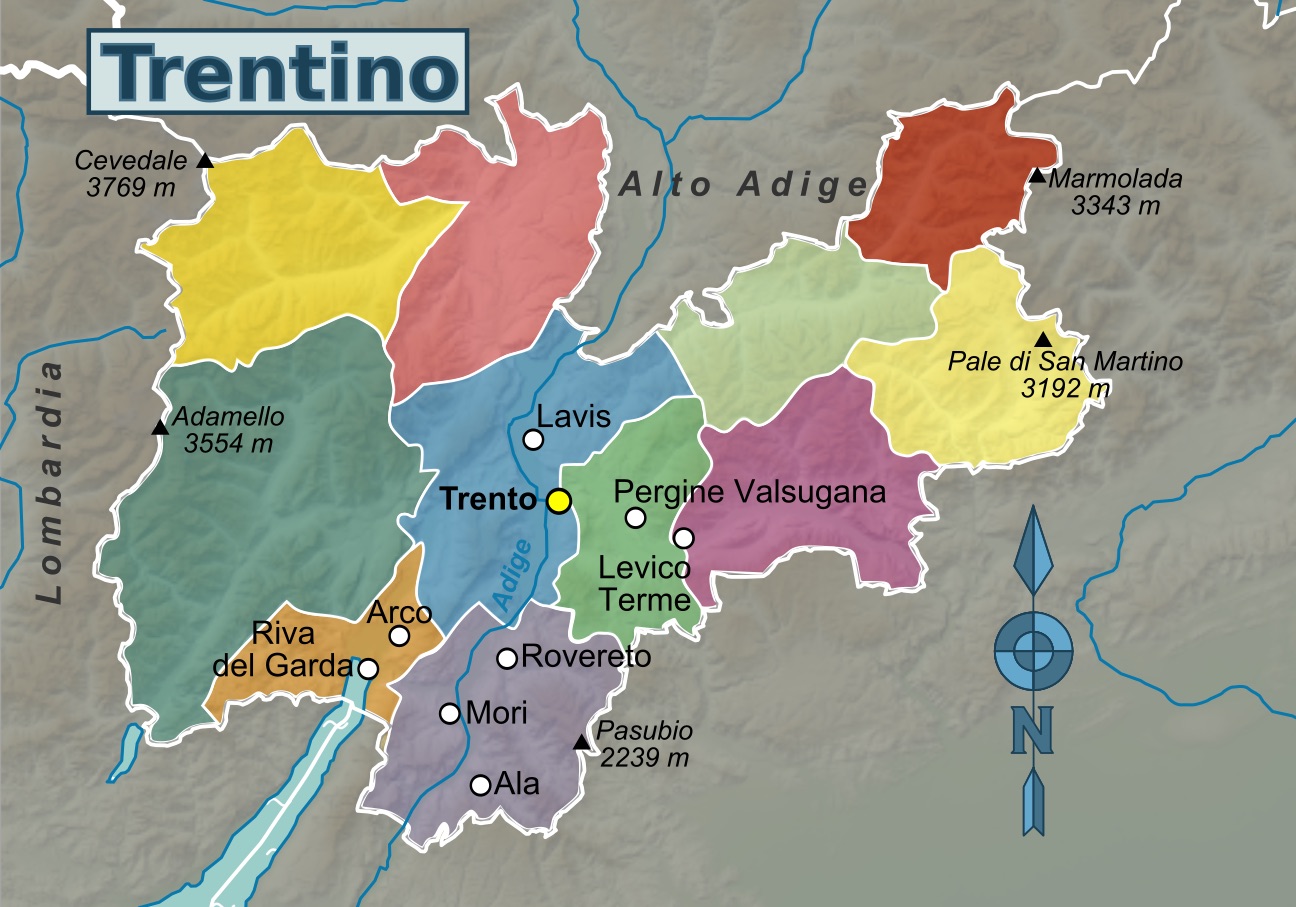
Trentodoc was born from the intuition of Giulio Ferrari in the early 20th century. In fact, after having worked in France, he began the production of metodo classico in Trentino. Today, following in the footsteps of this famous pioneer, the Trentodoc denomination allows for the use of four varieties: Chardonnay, Pinot Nero, Pinot Bianco and Meunier, and guarantees second fermentation in the bottle. Trentodoc is like Champagne in this way, and the shared classic method is a commitment to make wine of the upmost quality. The similarity I find with Prosecco and Piedmont sparkling wines is the “Italianness” of the final result: our Italian way of putting boundless passion and creativity into the things we do.
4. Your wines spend a good deal of time on the lees. What is the purpose of this method?
Thanks to the research by the Edmund Mach Foundation (in addition to the school there is a lot of research!), they discovered that the contact with the lees following the second fermentation in the bottle increases both the number of aromatic molecules and their quantity, which continues to develop over time. Here we can enjoy a Trentodoc aged for a long time on the lees as well as those disgorged after extraordinary lengths of time, both types showing a different evolution and maturity. In this regard, we will shortly propose our first Monfort Rare Vintage 2008, disgorged in January 2020 after 11 years of aging on the lees. Just a few bottles that demonstrate that aging on the lees is good.
5. What is your own background as a winemaker?
I grew up in the family business and was raised right in the vineyards. I was lucky enough to have a dad who was able to let me do it, let me make mistakes and thus learn from my mistakes. During my studies at the Istituto di San Michele and immediately afterwards I had internship experiences that helped me a lot: Fontodi (Tuscany), Albrecht-Kiessling (Germany), Château Margaux (France) and Spy Valley (New Zealand ). No experiences with metodo classico but all based on the high quality wines. However, the production in the company is not entrusted only to me, but to a team of people that I respect a lot, with the senior oenologist Maurizio Iachemet, flanked by Lorenzo Pellegrini, my fellow student, also trained as an oenologist.
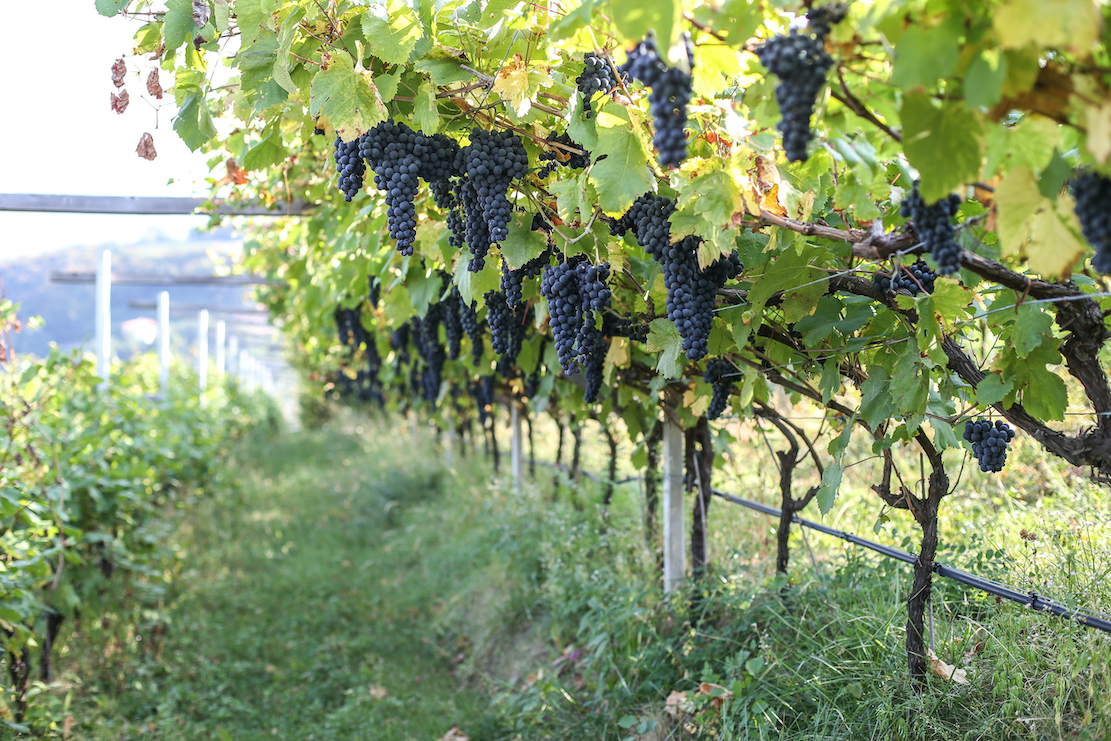
6. Why do you think Trentino has not gotten the same attention that other Italian regions have?
Given that Trentino represents 2% of national production, I think that after the war it has undergone numerous changes and has only began to establish itself as an area that produces high quality in the last 30 years. I’ll add that as mountain people, we are hard workers but of few words, so we have always found it difficult to describe our products. I am convinced that the new generations, who are open and traveling the world, will be able to take the baton that our parents have passed us and move forward with the development of alternative techniques and a different approach to the market.
7. How many different sparkling wines do you make?
Cantine Monfort produces three Trentodoc: base, reserva and rosé. Starting from the latter, the Trentodoc Monfort Rosè is a product that was introduced with the 2008 harvest. We immediately understood that we liked to make rosè. We seek its maximum expression in elegance, and the consumer continues to appreciate it more. This 2020 ends with the presentation of Monfort Cuvée '85, a Trentodoc made from a selection of Chardonnay and Pinot Nero grapes, elevating the original recipe of the cuvée produced for the first time in 1985. Moreover, at the end of the year we’ll release, for the first time, our Monfort Rare Vintage 2008, a late disgorgement of great character. In 2021 we will start the year with the evolution of our Monfort Riserva, which will come out with a new cuvée that enhances the territory and its vertical characteristics. I cannot reveal the name yet, but in January we will be ready to start 2021 in the best way. We are also refining another Trentodoc that I am particularly fond of: our Blanc de Noir which comes from Maurizio’s old Pinot Nero vineyards in Val di Cembra, he is our senior winemaker. However, we have to be patient a little longer.
8. What are the principal wine varieties you use?
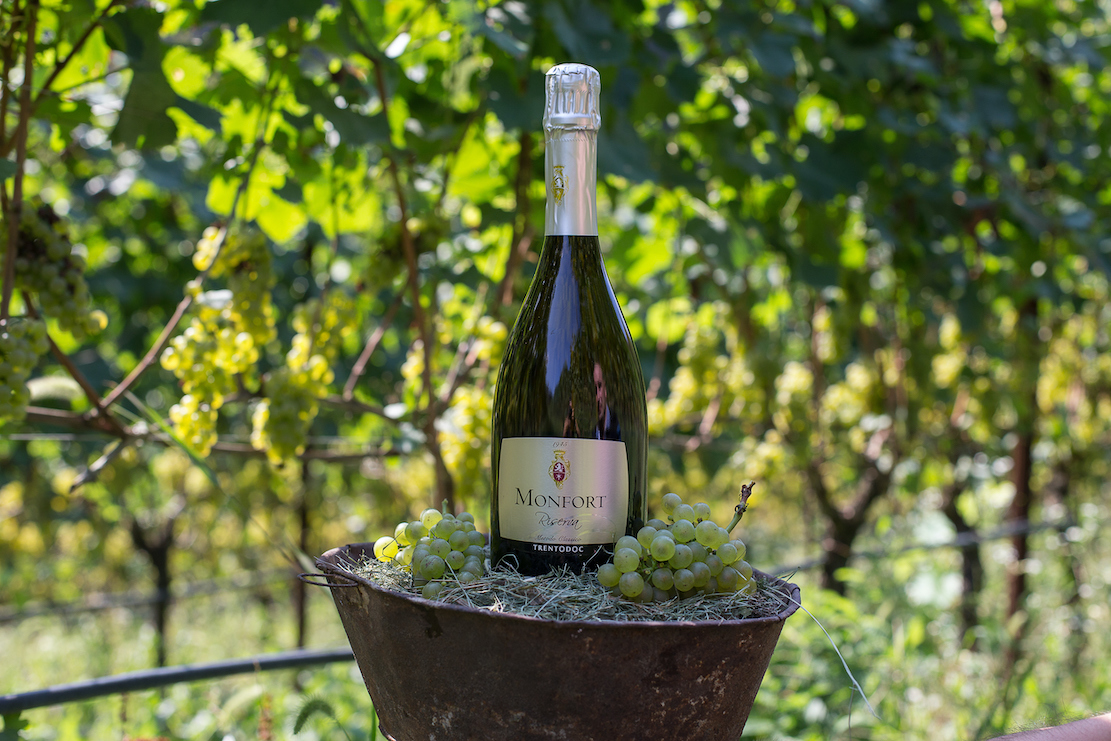
Cantine Monfort uses Chardonnay and Pinot Noir. Over the last few years, we have defined the vineyards we allocate for the various types we produce, and this is really something interesting. It surprises me every time how vineyards managed by the same winemaker, vinified by the same winemaker, give different characteristics in relation to the geological component of the soil. Very beautiful.
9. How has climate change affected Trentino?
Trentino is an area affected by climate change whose aspects of most concern that are intensely being manifested over the last 5-6 years are the very strong winds, the hailstorms that can hit large areas and the unprecedented heavy rain storms. We face global warming by raising the share of Trentino's viticulture and in this, compared to other territories, we have an advantage, but honestly, in recent years, production has become very complex.
10. How has Covid affected Trentino, its wine sales, tourism, etc.
Trentodoc is something that brings people together; you can pop a bottle of metodo classico when you want to celebrate or when you are in good company, but since the lockdown made this impossible, sales have gone down. During the summer of 2020 we recovered sales and today we are happy. At the end of October, we can only hope that the new restrictions will not affect consumption too much since the last months of the year are very important for our sales. The same thing goes for tourism. We had a record summer for the winery; in fact, many tourists, mostly Italians, literally invaded the region (lakes, excursions in the Dolomites, wine tourism). However, winter tourism linked to the numerous ski resorts throughout our Trentino is at risk. As far as exports are concerned, each country reacted differently: we have not been affected by the crisis in countries with very strong domestic consumption; indeed, in some we have also increased sales (Sweden, Germany, Holland), while in more tourist locations we have had a strong slowdown with positive signs only in recent months (for example Mexico).

ONE OF MANY THINGS
WE DOUBT GRANOLA
EVER CHANGED
"The Mentor We Miss
Most: Molly O’Neill: The writer and chef’s LongHouse
Food Scholars Program changed many a writers'
lives—and so did her granola."—Ellen Grey, Saveur
(Oct. 2020).
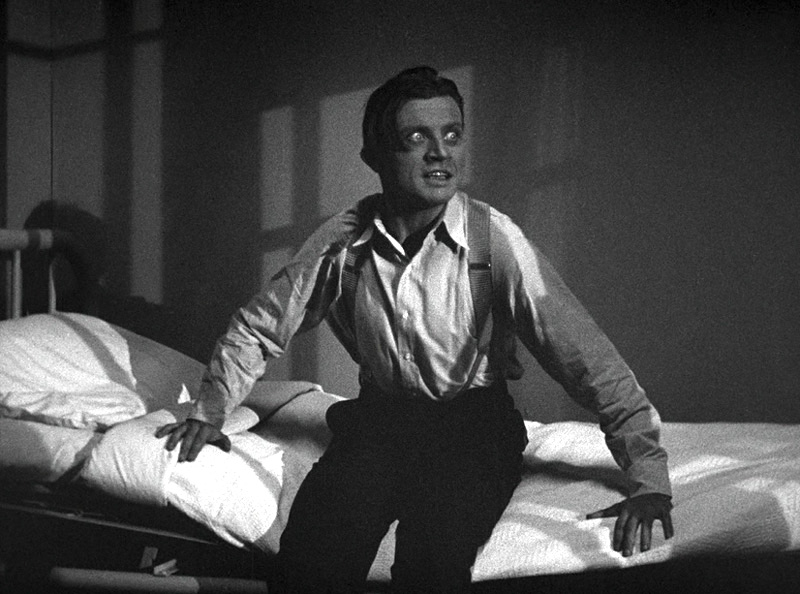
MOST SHOCKING HEADLINE OF THE WEEK!
"Coffee
Ice
Cream May Contain Caffeine" by Taylor Rock, DailyMeal.com
(Pct. 19, 2020)
❖❖❖
Sponsored by

Any of John Mariani's books below may be ordered from amazon.com.
 The Hound in Heaven
(21st Century Lion Books) is a novella, and
for anyone who loves dogs, Christmas, romance,
inspiration, even the supernatural, I hope you'll find
this to be a treasured favorite. The story
concerns how, after a New England teacher, his wife and
their two daughters adopt a stray puppy found in their
barn in northern Maine, their lives seem full of promise.
But when tragedy strikes, their wonderful dog Lazarus and
the spirit of Christmas are the only things that may bring
his master back from the edge of despair.
The Hound in Heaven
(21st Century Lion Books) is a novella, and
for anyone who loves dogs, Christmas, romance,
inspiration, even the supernatural, I hope you'll find
this to be a treasured favorite. The story
concerns how, after a New England teacher, his wife and
their two daughters adopt a stray puppy found in their
barn in northern Maine, their lives seem full of promise.
But when tragedy strikes, their wonderful dog Lazarus and
the spirit of Christmas are the only things that may bring
his master back from the edge of despair. WATCH THE VIDEO!
“What a huge surprise turn this story took! I was completely stunned! I truly enjoyed this book and its message.” – Actress Ali MacGraw
“He had me at Page One. The amount of heart, human insight, soul searching, and deft literary strength that John Mariani pours into this airtight novella is vertigo-inducing. Perhaps ‘wow’ would be the best comment.” – James Dalessandro, author of Bohemian Heart and 1906.
“John Mariani’s Hound in Heaven starts with a well-painted portrayal of an American family, along with the requisite dog. A surprise event flips the action of the novel and captures us for a voyage leading to a hopeful and heart-warming message. A page turning, one sitting read, it’s the perfect antidote for the winter and promotion of holiday celebration.” – Ann Pearlman, author of The Christmas Cookie Club and A Gift for my Sister.
“John Mariani’s concise, achingly beautiful novella pulls a literary rabbit out of a hat – a mash-up of the cosmic and the intimate, the tragic and the heart-warming – a Christmas tale for all ages, and all faiths. Read it to your children, read it to yourself… but read it. Early and often. Highly recommended.” – Jay Bonansinga, New York Times bestselling author of Pinkerton’s War, The Sinking of The Eastland, and The Walking Dead: The Road To Woodbury.
“Amazing things happen when you open your heart to an animal. The Hound in Heaven delivers a powerful story of healing that is forged in the spiritual relationship between a man and his best friend. The book brings a message of hope that can enrich our images of family, love, and loss.” – Dr. Barbara Royal, author of The Royal Treatment.
 |
The Encyclopedia of American Food and Drink by John F. Mariani (Bloomsbury USA, $35) Modesty forbids me to praise my own new book, but let me proudly say that it is an extensive revision of the 4th edition that appeared more than a decade ago, before locavores, molecular cuisine, modernist cuisine, the Food Network and so much more, now included. Word origins have been completely updated, as have per capita consumption and production stats. Most important, for the first time since publication in the 1980s, the book includes more than 100 biographies of Americans who have changed the way we cook, eat and drink -- from Fannie Farmer and Julia Child to Robert Mondavi and Thomas Keller. "This book is amazing! It has entries for everything from `abalone' to `zwieback,' plus more than 500 recipes for classic American dishes and drinks."--Devra First, The Boston Globe. "Much needed in any kitchen library."--Bon Appetit. |
"Eating Italian will never be the same after reading John Mariani's entertaining and savory gastronomical history of the cuisine of Italy and how it won over appetites worldwide. . . . This book is such a tasteful narrative that it will literally make you hungry for Italian food and arouse your appetite for gastronomical history."--Don Oldenburg, USA Today. "Italian
restaurants--some good, some glitzy--far
outnumber their French rivals. Many of
these establishments are zestfully described
in How Italian Food Conquered the World, an
entertaining and fact-filled chronicle by
food-and-wine correspondent John F.
Mariani."--Aram Bakshian Jr., Wall Street
Journal.
"Equal parts
history, sociology, gastronomy, and just
plain fun, How Italian Food Conquered the
World tells the captivating and delicious
story of the (let's face it) everybody's
favorite cuisine with clarity, verve and
more than one surprise."--Colman Andrews,
editorial director of The Daily
Meal.com. "A fantastic and fascinating
read, covering everything from the influence
of Venice's spice trade to the impact of
Italian immigrants in America and the
evolution of alta cucina. This book will
serve as a terrific resource to anyone
interested in the real story of Italian
food."--Mary Ann Esposito, host of PBS-TV's
Ciao
Italia. "John Mariani has written the
definitive history of how Italians won their
way into our hearts, minds, and
stomachs. It's a story of pleasure over
pomp and taste over technique."--Danny Meyer,
owner of NYC restaurants Union Square
Cafe, The Modern, and Maialino.
|
 |
 |
 |
 |
 |
 |
 |
 |
 Everett Potter's Travel Report:
Everett Potter's Travel Report: 
 Eating Las
Vegas JOHN CURTAS has been covering
the Las Vegas food and restaurant scene
since 1995. He is the co-author of EATING LAS
VEGAS – The 50 Essential Restaurants (as
well as the author of the Eating Las
Vegas web site: www.eatinglasvegas.
He can also be seen every Friday morning as
the “resident foodie” for Wake Up With the
Wagners on KSNV TV (NBC) Channel 3 in
Las Vegas.
Eating Las
Vegas JOHN CURTAS has been covering
the Las Vegas food and restaurant scene
since 1995. He is the co-author of EATING LAS
VEGAS – The 50 Essential Restaurants (as
well as the author of the Eating Las
Vegas web site: www.eatinglasvegas.
He can also be seen every Friday morning as
the “resident foodie” for Wake Up With the
Wagners on KSNV TV (NBC) Channel 3 in
Las Vegas.
MARIANI'S VIRTUAL GOURMET
NEWSLETTER is published weekly. Publisher: John Mariani. Editor: Walter Bagley. Contributing Writers: Christopher Mariani,
Robert Mariani, Misha Mariani, John A. Curtas, Gerry Dawes, Geoff Kalish,
and Brian Freedman. Contributing
Photographer: Galina Dargery. Technical
Advisor: Gerry
McLoughlin.
If you wish to subscribe to this
newsletter, please click here: http://www.johnmariani.com/subscribe/index.html
© copyright John Mariani 2020

